|
 Other Shale Volume Methods
Other Shale Volume Methods
All of
these alternate shale volume methods are more than adequate, but
suffer from strict limitations on their use. EPT and capture cross
section are rare log curves.
A number of useful shale volume methods have more restricted
The reader should take a moment to define
the parameters and work a hypothetical numerical example.
 Shale Volume from Electromagnetic Propagation
Attenuation Shale Volume from Electromagnetic Propagation
Attenuation
The
electromagnetic propagation attenuation curve works well,
especially in thinly bedded sand-shale sequences because
the tool has a bed resolution of 4 to 6 inches. Attenuation
increases with shale volume.
1.
VSHept = (ATTEN - ATTEN_CLN) / (ATTEN_SHL - ATTEN_CLN)
2: VSHept = Min(1, Max(0, VSHept))
 Shale Volume from Deep Resistivity Shale Volume from Deep Resistivity
The
deep resistivity sometimes can be used in hydrocarbon
bearing zones, especially tar sands. Calculated shale volume
will be too high in water zones or swept zones when the
water is fairly salty (WS > 10000 ppm NaCl), so another
method, such as the SP or GR, should be used as well. Resistivity
decreases with higher shale volume. The method is very useful
in shallow shaly sands where kaolinite or feldspar makes
the gamma ray read high.
The
clean and shale resistivity values can be picked from suitable cross
plots or from depth plots.
For the resistivity log method,
the use of the logarithm of the resistivity log values (and
base line values) works better than linear values, as follows:
3. VSHresd = (log(RESD) - log(RESD_CLN)) / (log(RESD_SHL)
- log(RESD_CLN))
4: VSHresd = Min(1, Max(0, VSHresd))
Note
that RESD_CLN is greater than RESD_SHL
 Shale Volume from Shallow Resistivity Shale Volume from Shallow Resistivity
In
many shaly sands that are invaded with normal drilling mud
filtrate (Rmf >= 0.50 ohm-m), the shallow resistivity
may be a good shale indicator. Again, this is a very useful
method in feldspathic sandstones, and there is better bed
resolution than the deep resistivity. Do not use microlog
or microspherically focused log as RESS.
5. VSHress = (log(RESS) - log(RESS_CLN)) / (log(RESS_SHL)
- log(RESS_CLN))
6: VSHress = Min(1, Max(0, VSHress))
 Shale Volume from
capture cross section Shale Volume from
capture cross section
Some
newer neutron logs produce a capture cross section curve
(SIGMA) which mimics a gamma ray log in shaly sands:
7. VSHsig = (SIGMA – SIG_CLN) / (SIG_SHL – SIG_CLN)
8: VSHsig = Min(1, Max(0, VSHsig))
All
cased hole thermal decay time logs display a SIGMA curve
as one of the primary measurements. Although there are hydrocarbon
effects, the curve can sometimes be used to overcome problems
with the gamma ray log, such as uranium precipitation on
casing or tubing, or missing GR log.
 Shale Volume from Photo Electric Effect Shale Volume from Photo Electric Effect
This method is not very accurate as the spread between PE of
quartz and shale is not large.
9. VSHpe = (PE – PE_CLN) / (PE_SHL – PE_CLN)
10: VSHpe = Min(1, Max(0, VSHpe))
PE of
quartz is between 1.6 to 1.8 and illite shale is near 3.5. l
 Even
More Methods Even
More Methods
The equations reproduced in the table below provide most of the
known relationships for calculating shale volume. This material
is reprinted courtesy of Dresser Atlas.


|

